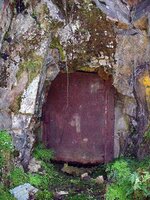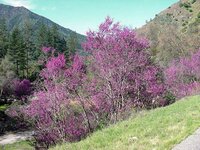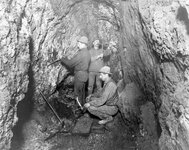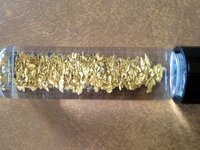Rowdy Yates
Full Member
This is a story about an experience I had almost 30 years ago during a year of hard-rock mining in Mariposa County back in the 1980's. No actual names are used, but the initials are real, just so if any of you old-timers know who I'm writing about, you will know who I'm talking about. This is the first "chapter". More to follow as I gather my thoughts and try to remember how it really was. Let me know if i should continue.......
The Entrance to the Gold Star Mine in 2004
In the spring of 1986, word began spreading around us local miners that an unknown, retired flatlander from Southern California was looking for a “few good men” to help him re-open and work one of the numerous abandoned hard rock mines in the area. Being unemployed at the time, me and ALM from Hite’s Cove stepped up. We offered to meet the retired flatlander at the home of JL, who lived in an older house on the banks of the Merced River near El Portal. JL had grown up here and owned quite a few of the hard rock claims in the area, and was offering to lease one of his claims to this gentleman for a year. Being in my mid-20s at the time, I was impressed with this older, mid-60ish, retired guy from Southern California. Having grown up in So Cal myself, we had quite a bit in common and we hit it off well. He was a general contractor, and his dream was to spend his retirement years getting rich, mining a gold mine. Since he was a general contractor, I knew he was familiar with heavy equipment, and he was bringing in an old miner he knew named J, who had a lifetime of experience mining in Happy Camp, California. At that meeting, I also learned he was going to lease the Rutherford & Cranberry mine. I knew the history of this mine, and when I heard which mine he was planning to re-open, I knew he just might have a chance!
Link to the Rutherford/Cranberry Mine: Rutherford & Cranberry Mines, Clearing House, Clearing House District, East Belt, Mariposa Co., California, USA
The Rutherford/Cranberry Mine, El Portal, California in 2004
ALM and I agreed to hire on immediately. Our new boss was named GH, and we decided that we needed an additional worker, so we hired on another local miner, nicknamed “Yosemite” S. So here we were, a 5 man team - GH the boss, J the miner from Happy Camp, ALM from Hite’s Cove, Yosemite S, and, me.
The next few weeks were spent getting preparations ready. The entrance to the mine is at an elevation of approximately 1,300 feet above the floor of the Merced River Canyon, and is only accessible on an extremely narrow and steep 4 wheel-drive road. I had a 1957 Willy’s M38-A1 (first military Jeep with rounded front fenders) and GH had a 1970 Ford Bronco 4x4 with a 302. Our first job was to cut, clear, and make the road to the mine as safe and accessible as possible. After a few days of steady work on clearing the road, we were able to access the mine as quickly as our vehicles would allow.
I’ll never forget the first time I arrived at the mine. The entrance was heavily timbered, and was secured by an iron door similar to the one I had rebuilt at the Gold Star Mine, just a year earlier. There was a 10’ x 20’ skid shed there, which would become our combination office, kitchen, barracks, and general shelter while we were working the mine. We out-fitted it with a few bunks, a desk, and a propane refrigerator, heater and stove. There was a large flat area (about 1/8-acre) in front of the mine entrance, mostly encompassing the top of the substantial tailings pile. The most incredible part, though, was the mining-gauge railroad track extending out of the entrance to the mine, across the flats, to the top of the tailings pile, and a beautifully intact ore cart sitting on the tracks. I swear I saw it sparkle in the sun! At this point, I knew I was to become a bona-fide hard rock miner!
After clearing the road and establishing the mine entrance, it became apparent that we were never going to get GH’s late 1960’s Ford 10-wheeler dump truck up to the mine, so we decided to transport the mill up to the mine, instead of transporting the ore in the 10-wheeler down the steep mountain to our previously established mill site on the river. The mill site was essentially our home base on the Merced River. I don’t know how GH worked it out with the Forest Service (he must have filed a mill-site claim for the spot) but, we took over a fairly large flat on the banks of the Merced River about ¼ mile upstream from the road leading up to the mine. The spot had previously been used as an impromptu campground and had a large campfire pit where we spent many a night slugging down cheap beer and discussing our triumphs and, later on, our downfalls around huge campfires.
Not only was the 10-wheeler parked there indefinitely (we never ended up really using it), but initially all of our equipment resided there at one time or another. GH had acquired a vintage 1945 WWII commercial air-compressor, a gasoline-powered jaw-crusher and a large, trailer-mounted ball mill. Electricity for the mill site and the mine site was provided by two small Honda generators. The ball mill never made it to the mine (too big for the road), but we did get the jaw-crusher up there to pre-process the ore. Also, at the mill site is where J, the old miner, had brought in an 18-wheeler semi-truck trailer converted into his living quarters and a small fire-assay lab, which was permanently moved onto the site. Just like the shed at the mine entrance, it was equipped with propane and had a refrigerator, heater, and stove, along with an assaying furnace. I spent countless hours with J here, learning various assaying techniques, which came in very handy a few years later when I got a job doing fire-assay at Bondar Clegg in Reno, Nevada.
The Merced RiverCanyon Just Upstream From the Mill Site
More to come.........
Amazon Forum Fav 👍
Last edited by a moderator:








 . I have a few stories myself, but then again, if there isn't much interest shown in the community after starting the story, I can see why you might be hesitant to invest the time it takes to recount your experiences. Either way, I have enjoyed what you've written so far. Thanks
. I have a few stories myself, but then again, if there isn't much interest shown in the community after starting the story, I can see why you might be hesitant to invest the time it takes to recount your experiences. Either way, I have enjoyed what you've written so far. Thanks


